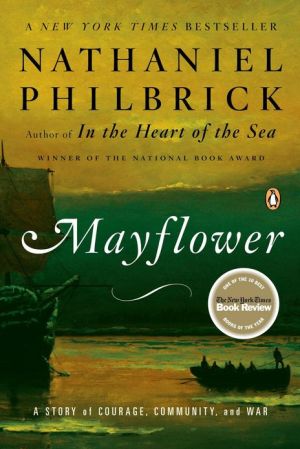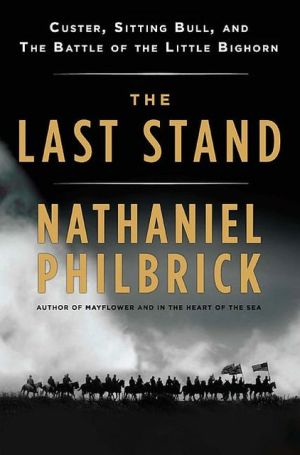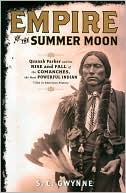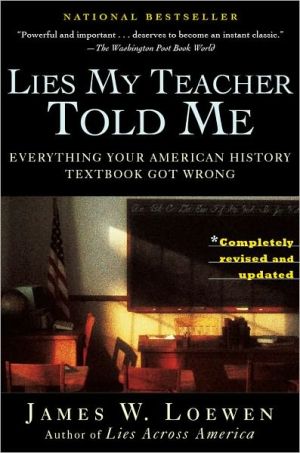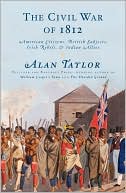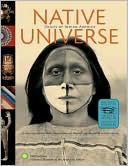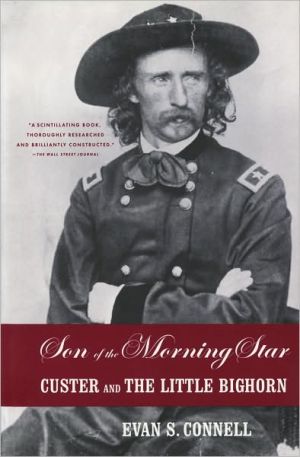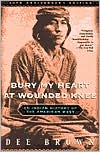Mayflower: A Story of Courage, Community, and War
Nathaniel Philbrick became an internationally renowned author with his National Book Award? winning In the Heart of the Sea, hailed as 'spellbinding' by Time magazine. In Mayflower, Philbrick casts his spell once again, giving us a fresh and extraordinarily vivid account of our most sacred national myth: the voyage of the Mayflower and the settlement of Plymouth Colony. From the Mayflower?s arduous Atlantic crossing to the eruption of King Philip's War between colonists and natives decades...
Search in google:
From the bestselling author of In the Heart of the Sea -- winner of the National Book Award -- the startling story of the Plymouth Colony. From the perilous ocean crossing to the shared bounty of the first Thanksgiving, the Pilgrim settlement of New England has become enshrined as our most sacred national myth. Yet, as bestselling author Nathaniel Philbrick reveals in his spellbinding new book, the true story of the Pilgrims is much more than the well-known tale of piety and sacrifice; it is a fifty-five-year epic that is at once tragic, heroic, exhilarating, and profound. The Mayflower's religious refugees arrived in Plymouth Harbor during a period of crisis for Native Americans as disease spread by European fishermen devastated their populations. Initially the two groups -- the Wampanoags, under the charismatic and calculating chief Massasoit, and the Pilgrims, whose pugnacious military officer Miles Standish was barely five feet tall -- maintained a fragile working relationship. But within decades, New England would erupt into King Philip's War, a savagely bloody conflict that nearly wiped out English colonists and natives alike and forever altered the face of the fledgling colonies and the country that would grow from them. With towering figures like William Bradford and the distinctly American hero Benjamin Church at the center of his narrative, Philbrick has fashioned a fresh and compelling portrait of the dawn of American history-a history dominated right from the start by issues of race, violence, and religion. For sixty-five days, the Mayflower had blundered her way through storms and headwinds, her bottom a shaggy pelt of seaweed and barnacles, her leaky decks spewing salt walter onto her passengers' devoted heads. There were 102 of them -- 104 if you counted the two dogs: a spaniel and a giant, slobbery mastiff . . . . They were a most unusual group of colonists. Instead of noblemen, craftsmen, and servants -- the types of people who had founded Jamestown in Virginia -- these were, for the most part, families: men, women, and children who were willing to endure almost anything if it meant they could worship as they pleased . . . . It was a stunningly audacious proposition. With the exception of Jamestown, all other attempts to establish a permanent English settlement on the North American continent had so far failed. And Jamestown, founded in 1607, could hardly be counted a success . . . . Between 1619 and 1622, the Virginia Company would send close to 3,600 settlers to the colony; over that three-year period, 3,000 would die. In addition to starvation and disease, there was the threat of Indian attack. At the university library in Leiden [the town in Holland where the Puritans had lived] were sensational accounts left by earlier explorers and settlers, telling how the Indians "delight to torment men in the most bloody manner that may be; flaying some alive with the shells of fishes, cutting off the members and joints of others by piecemeal and broiling on the coals." How could parents willingly subject their children to the risk of such a fate? In the end, all arguments for and against emigrating to America ended with the conviction that God wanted them to go. Salon.com A signal achievement. Philbrick enlightens and even astounds. (Salon.com)
Mayflower\ \ By Nathaniel Philbrick \ Viking Adult\ ISBN: 0-670-03760-5 \ \ \ Chapter One\ They Knew They Were Pilgrims \ For sixty-five days, the Mayflower had blundered her way through storms and headwinds, her bottom a shaggy pelt of seaweed and barnacles, her leaky decks spewing salt water onto her passengers' devoted heads. There were 102 of them-104 if you counted the two dogs: a spaniel and a giant, slobbery mastiff. Most of their provisions and equipment were beneath them in the hold, the primary storage area of the vessel. The passengers were in the between, or 'tween, decks-a dank, airless space about seventy-five feet long and not even five feet high that separated the hold from the upper deck. The 'tween decks was more of a crawlspace than a place to live, made even more claustrophobic by the passengers' attempts to provide themselves with some privacy. A series of thin-walled cabins had been built, creating a crowded warren of rooms that overflowed with people and their possessions: chests of clothing, casks of food, chairs, pillows, rugs, and omni-present chamber pots. There was even a boat-cut into pieces for later assembly-doing temporary duty as a bed.\ They were nearly ten weeks into a voyage that was supposed to have been completed during the balmy days of summer. But they had started late, and it was now November, and winter was coming on. They had long since run out of firewood, and they were reaching the slimy bottoms of their water casks. Of even greaterconcern, they were down to their last casks of beer. Due to the notoriously bad quality of the drinking water in seventeenth-century England, beer was considered essential to a healthy diet. And sure enough, with the rationing of their beer came the unmistakable signs of scurvy: bleeding gums, loosening teeth, and foul-smelling breath. So far only two had died-a sailor and a young servant-but if they didn't reach land soon many more would follow.\ They had set sail with three pregnant mothers: Elizabeth Hopkins, Susanna White, and Mary Allerton. Elizabeth had given birth to a son, appropriately named Oceanus, and Susanna and Mary were both well along in their pregnancies.\ It had been a miserable passage. In midocean, a fierce wave had exploded against the old ship's topsides, straining a structural timber until it had cracked like a chicken bone. The Mayflower's master, Christopher Jones, had considered turning back to England. But Jones had to give his passengers their due. They knew next to nothing about the sea or the savage coast for which they were bound, but their resolve was unshakable. Despite all they had so far suffered-agonizing delays, seasickness, cold, and the scorn and ridicule of the sailors-they had done everything in their power to help the carpenter repair the fractured beam. They had brought a screw jack-a mechanical device used to lift heavy objects-to assist them in constructing houses in the New World. With the help of the screw jack, they lifted the beam into place, and once the carpenter had hammered in a post for support, the Mayflower was sound enough to continue on.\ They were a most unusual group of colonists. Instead of noblemen, craftsmen, and servants-the types of people who had founded Jamestown in Virginia-these were, for the most part, families-men, women, and children who were willing to endure almost anything if it meant they could worship as they pleased. The motivating force behind the voyage had come from a congregation of approximately four hundred English Puritans living in Leiden, Holland. Like all Puritans, these English exiles believed that the Church of England must be purged of its many excesses and abuses. But these were Puritans with a vengeance. Instead of working for change within the established church, they had resolved to draw away from the Church of England-an illegal act in Jacobean England. Known as Separatists, they represented the radical fringe of the Puritan movement. In 1608, they had decided to do as several groups of English Separatists had done before them: emigrate to the more religiously tolerant country of Holland.\ They had eventually settled in Leiden, a university town that could not have been more different from the rolling, sheep-dotted fields of their native England. Leiden was a redbrick labyrinth of building-packed streets and carefully engineered canals, a city overrun with refugees from all across Europe. Under the leadership of their charismatic minister, John Robinson, their congregation had more than tripled in size. But once again, it had become time for them to leave.\ As foreigners in Holland, many of them had been forced to work menial, backbreaking jobs in the cloth industry, and their health had suffered. Despite the country's reputation for religious tolerance, a new and troubling era had come to Holland as a debate among the leading theologians of the day sparked civil unrest and, on occasion, violence. Just the year before, a member of their congregation had almost been killed by a rock-hurling crowd. Even worse, a Dutch treaty with Spain was about to expire, and it was feared Leiden might soon be subjected to the same kind of siege that had resulted in the deaths of half the city's residents during the previous century.\ But their chief worry involved their children. Gradually and inevitably, they were becoming Dutch. The congregation had rejected the Church of England, but the vast majority of its members were still proudly, even defiantly, English. By sailing to the New World, they hoped to re-create the English village life they so dearly missed while remaining beyond the meddlesome reach of King James and his bishops.\ It was a stunningly audacious proposition. With the exception of Jamestown, all other attempts to establish a permanent English settlement on the North American continent had so far failed. And Jamestown, founded in 1607, could hardly be counted a success. During the first year, 70 of 108 settlers had died. The following winter came the "starving time," when 440 of 500 settlers were buried in just six months. As it turned out, the most lethal days in Jamestown were yet to come. Between 1619 and 1622, the Virginia Company would send close to 3,600 settlers to the colony; over that three-year period, 3,000 would die.\ In addition to starvation and disease, there was the threat of Indian attack. At the university library in Leiden were sensational accounts left by earlier explorers and settlers, telling how the Indians "delight to torment men in the most bloody manner that may be; flaying some alive with the shells of fishes, cutting off the members and joints of others by piecemeal and broiling on the coals." How could parents willingly subject their children to the risk of such a fate?\ In the end, all arguments for and against emigrating to America ended with the conviction that God wanted them to go. The world, they believed, was on the verge of the millennium-the thousand-year rule of the saints predicted in the book of Revelation. In 1618, a comet appeared in the skies over Europe, signaling, many thought, the final, apocalyptic battle of good against evil. And, in fact, what became known as the Thirty Years' War would rage across the Continent as Protestant and Catholic forces reduced much of Europe to a burning, corpse-strewn battleground. So far, England had avoided this conflict, and as all God-fearing English Puritans knew, their country had been earmarked by the Lord to lead his forces in triumph. Instead of Europe, perhaps America, a continent previously dominated by the Catholic powers of Spain and France, was where God intended to bring the reformed Protestant Church to perfection. All Englishmen had heard of the atrocities the Spaniards' hateful hunt for gold had inflicted on the Indians of America. England, it had been predicted by Richard Hakluyt, the chronicler of British exploration, would do it differently. It was the Leideners' patriotic and spiritual duty to plant a godly English plantation in the New World. "We verily believe and trust the Lord is with us," they wrote, "and that He will graciously prosper our endeavors according to the simplicity of our hearts therein."\ Their time in Leiden, they now realized, had been a mere rehearsal for the real adventure. "We are well weaned from the delicate milk of our mother country," they wrote, "and inured to the difficulties of a strange and hard land, which yet in a great part we have by patience overcome." Most important, however, they were "knit together as a body in a most strict and sacred bond."\ They were weavers, wool carders, tailors, shoemakers, and printers, with almost no relevant experience when it came to carving a settlement out of the American wilderness. And yet, because of the extraordinary spiritual connection they had developed as exiles in Leiden and even before, they were prepared for whatever lay ahead. "[I]t is not with us as with other men," they confidently insisted, "whom small things can discourage, or small discontentments cause to wish themselves home again." Or, as one of their number, a thirty-year-old corduroy worker named William Bradford, later wrote, "they knew they were pilgrims."\ Taking Bradford's lead, we refer to them today as the Pilgrims, a name that is as good as any to describe a people who were almost always on the move-even after they had supposedly found a home in America. If not for Bradford's steady, often forceful leadership, it is doubtful whether there ever would have been a colony. Without his Of Plymouth Plantation, certainly the greatest book written in seventeenth-century America, there would be almost no information about the voyage with which it all began. For William Bradford, however, the true voyage had begun close to twenty years before.\ Bradford was born in the tiny farming town of Austerfield, Yorkshire, deep in northern England, where the closest thing to a wilderness was the famed Sherwood Forest to the south. The Great North Road from London to Edinburgh (actually more of a ribbon of mud than a proper road) passed nearby, but few from Austerfield had ever ventured far from home.\ Although he came from a family of prosperous, land-rooted farmers, Bradford had experienced more than his share of dislocation and loss. By the time he turned twelve, he had lost not only his father, his mother, and a sister, but also the grandfather who had raised him. Soon after moving in with his two uncles, he was struck by a mysterious ailment that prevented him from working in the fields. Bradford later claimed that his "long sickness" had saved him from "the vanities of youth, and made him the fitter for what he was afterwards to undergo." Most important, his illness gave him the opportunity to read.\ Lonely and intelligent, he looked to the Bible for consolation and guidance. For a boy in need of instruction, the Geneva Bible, translated in the previous century by a small team of English ministers and equipped with helpful notes and appendices, was just the thing. There was also John Foxe's Book of Martyrs, a compelling, tremendously popular account of the Protestants martyred by Queen Elizabeth's Catholic predecessor on the throne, "Bloody Mary." Foxe's insistence that England was, like Israel before it, God's chosen nation had a deep and lasting influence on Bradford, and as Foxe made horrifyingly clear, to be a godly Englishman sometimes required a person to make the ultimate sacrifice.\ At issue at the turn of the seventeenth century-and long before-was the proper way for a Christian to gain access to the will of God. Catholics and more conservative Protestants believed that the traditions of the church contained valid, time-honored additions to what was found in the Bible. Given man's fallen condition, no individual could presume to question the ancient, ceremonial truths of the established church.\ But for the Puritans, man's fallen nature was precisely the point. All one had to do was witness a typical Sunday service in England-in which parishioners stared dumbly at a minister mumbling incomprehensible phrases from the Book of Common Prayer-to recognize how far most people were from a true engagement with the word of God.\ A Puritan believed it was necessary to venture back to the absolute beginning of Christianity, before the church had been corrupted by centuries of laxity and abuse, to locate divine truth. In lieu of time travel, there was the Bible, with the New Testament providing the only reliable account of Christ's time on earth while the Old Testament contained a rich storehouse of still vital truths. If something was not in the scriptures, it was a man-made distortion of what God intended. At once radical and deeply conservative, the Puritans had chosen to spurn thousands of years of accumulated tradition in favor of a text that gave them a direct and personal connection to God.\ A Puritan had no use for the Church of England's Book of Common Prayer, since it tampered with the original meaning of the Bible and inhibited the spontaneity that they felt was essential to attaining a true and honest glimpse of the divine. Hymns were also judged to be a corruption of God's word-instead, a Puritan read directly from the Bible and sang scrupulously translated psalms whose meaning took precedence over the demands of rhyme and meter. As staunch "primitivists," Puritans refused to kneel while taking communion, since there was no evidence that the apostles had done so during the Last Supper. There was also no biblical precedent for making the sign of the cross when uttering Christ's name. Even more important, there was no precedent for the system of bishops that ran the Church of England. The only biblically sanctioned organizational unit was the individual congregation.\ The Puritans believed that a congregation began with a covenant (a term they took from the Bible) between a group of believers and God. As a self-created and independent entity, the congregation elected a university-trained minister and, if the occasion should arise, voted him out. The Puritans also used the concept of a covenant to describe the individual's relationship with God. Ever since the Fall, when Adam had broken his covenant of works with God, man had been deserving of perpetual damnation. God had since made a covenant with Christ; upon the fulfillment of that covenant, God had offered a covenant of grace to just a small minority of people, known as the Saints.\ The Puritans believed that the identity of the Saints had long since been determined by God. This meant that there was nothing a person could do to win salvation. But instead of being a reason to forsake all hope, what was known as predestination became a powerful goad to action. No one could be entirely sure as to who was one of the elect, and yet, if a person was saved, he or she naturally lived a godly life. As a result, the Puritans were constantly comparing their own actions to those of others, since their conduct might indicate whether or not they were saved. Underlying this compulsive quest for reassurance was a person's conscience, which one divine described as "the voice of God in man."\ A Puritan was taught to recognize the stages by which he or she might experience a sureness of redemption. It began with a powerful response to the "preaching of the word," in which God revealed the heights to which a person must aspire if he or she was to achieve grace. This was followed by a profound sense of inadequacy and despair that eventually served as a prelude to, if a person was destined to be redeemed, "saving grace." From this rigorous program of divine discipline a Puritan developed the confidence that he or she was, in fact, one of the elect. For William Bradford, who had lost almost everyone he had ever loved, this emotionally charged quest for divinity would lead not only to the assurance of his own redemption but to the family he had never known.\ Bradford was just twelve years old when he became uneasy with the way God was worshipped in Austerfield. Like just about every village in England, Austerfield possessed a small stone church built soon after the Norman Conquest in the eleventh century. But the Austerfield church, known as St. Helena's, was-and is-unusual. Over the door is a primitive stone carving from a much earlier era depicting an open-mouthed snake. One can only wonder whether this weird, almost runic figure first suggested to the young Bradford that the Puritans were right: the Church of England had been poisoned by "that old serpent Satan." He must seek out a congregation of like-minded believers and worship God as the Bible instructed.\ In Scrooby, an even tinier town than Austerfield a few miles down the road in northern Nottinghamshire, he eventually found what he was looking for. In an old manor house, just a few decades from being demolished, lived the town's postmaster, William Brewster. It was here that a group of Separatists gathered every Sunday to worship in secret under the direction of two ministers, one of whom was the young John Robinson.\ (Continues...)\ \ \ \ \ Excerpted from Mayflower by Nathaniel Philbrick Excerpted by permission.\ All rights reserved. No part of this excerpt may be reproduced or reprinted without permission in writing from the publisher.\ Excerpts are provided by Dial-A-Book Inc. solely for the personal use of visitors to this web site. \ \
List of Maps ixPreface: The Two Voyages xiDiscoveryThey Knew They Were Pilgrims 3Dangerous Shoals and Roaring Breakers 35Into the Void 48Beaten with Their Own Rod 56The Heart of Winter 78In a Dark and Dismal Swamp 93Thanksgiving 104AccommodationThe Wall 123A Ruffling Course 140CommunityOne Small Candle 161The Ancient Mother 183The Trial 198WarKindling the Flame 229The God of Armies 259In a Strange Way 284The Better Side of the Hedge 311Epilogue: Conscience 345Afterword and Acknowledgments 359Mayflower Passenger List 362Notes 365Bibliography 417Index 447Picture Credits 464
\ From Barnes & NobleOver the years, the story of the Plymouth Colony has degraded into a threadbare tableau about a single hard Massachusetts winter that dissolves into a cheery Pilgrim-Indian feast. That crude cartoon will collapse under the sheer force of this epic tale of violence penned by the author of the National Book Award-winning In the Heart of the Sea. Nathaniel Philbrick's narrative tracks the Pilgrims from their perilous 1620 transatlantic crossing to the bloody battles of King Philip's War (1675-76). With compelling detail, he describes the delicate social ecology achieved by the Pilgrims and Native Americans before it was broken by a deadly war of attrition. His carefully modulated story blends acts of settler courage and kindness with those of savagery and cowardice. A major nonfiction work.\ \ \ \ \ The New York Times Book ReviewVivid and remarkably fresh ... Philbrick has recast the Pilgrims for our age.\ \ \ The Boston GlobeGripping ... a fascinating story, and one Philbrick tells very well.\ \ \ \ \ The New York TimesStartling [and] fascinating.\ \ \ \ \ Los Angeles TimesPhilbrick triumphs in Mayflower.\ \ \ \ \ Salon.comA signal achievement. Philbrick enlightens and even astounds. (Salon.com)\ \ \ \ \ The Baltimore SunA splendid account of a nearly forgotten era in America's Colonial past.\ \ \ \ \ Janet Maslin… [Philbrick] has written a judicious, fascinating work of revisionist history. Mayflower is a surprise-filled account of what are supposed to be some of the best-known events in this country's past but are instead an occasion for collective amnesia. As Mr. Philbrick points out, the national memory tends to skip from the first Thanksgiving to the Shot Heard 'Round the World without a clue about the 150 years in between.\ — The New York Times\ \ \ \ \ Jonathan YardleyWe like our history sanitized and theme-parked and self-congratulatory, not bloody and angry and unflattering. But if Mayflower achieves the wide readership it deserves, perhaps a few Americans will be moved to reconsider all that.\ — The Washington Post\ \ \ \ \ Publishers WeeklyWhat makes Philbrick's book so fascinating and accessible the way he turns the Pilgrim legend on its head and shakes out fresh insights from the crusty old mythology we all absorbed in grade school is present in full force in this exceptional audio version. With more than 800 audiobooks to his credit, Guidall gives the term "veteran reader" a whole new meaning. Such leading figures as William Bradford, Benjamin Church and Miles Standish of the so-called Plymouth Colony (which was not even close to Plymouth or its now-famous rock) emerge from the pages of history as understandable if not always admirable figures, and Guidall's evocations of the sadly depleted (by European diseases) Wampanoag Indians and their chief, Massasoit, are equally believable. The bitter voyage of the Seaflower (a slave ship taking captive Wampanoags to be sold in the Caribbean after a disastrous war with Massasoit's son, Philip), which rounds out Philbrick's masterful account, is treated with energy, respect and a straightforwardness that only increases its power. Simultaneous release with the Viking hardcover (Reviews, Feb. 6). (June) Copyright 2006 Reed Business Information.\ \ \ \ \ Library JournalPhilbrick (In the Heart of the Sea) provides the listener with a truly epic narrative, a fantastic tale that reveals much more than the simple myth we pull out every Thanksgiving. We see greed, stupidity, honor, bravery, suffering, hope, and deception with both the Plymouth Colony and the surrounding Native American tribes. The characters' names even ring through the ages Massasoit, Church, Bradford, Squanto, King Phillip, and Standish. From the rough ride over on the Mayflower through those first years where so many died to subsequent generations, this story is exciting from start to finish. One area that does prove surprising is the internal gamesmanship and infighting of the Native American tribes, culminating with King Phillip's War in 1675. George Guidall's narration is masterful; recommended for all public and academic libraries. Scott R. DiMarco, Mansfield Univ. of Pennsylvania Copyright 2006 Reed Business Information.\ \ \ \ \ Kirkus ReviewsKnown for his special talent with a sea story, National Book Award-winner Philbrick (Sea of Glory, 2003, etc.) here uses the Pilgrims' perilous Atlantic crossing as mere prelude to an even more harrowing tale of survival in an alien land. From the voyage of the Mayflower to the conclusion 56 years later of King Philip's War, this is a sensitive treatment of the transplanted Europeans' encountering of and clashes with the native tribes of the New World, all of which prefigured in many important respects the development of later American colonies. The strict discipline of the Pilgrims' intense spiritual commitment, responsible in many ways for the colony's initial success, inevitably gave rise to later political and religious schisms. Notwithstanding the forging of the Mayflower Compact, their political and economic lifeline stretched, vulnerably, across the ocean. More than anything, survival depended on alliances with Native Americans, and Philbrick excels at exploding commonly accepted notions about this complicated relationship. The Pilgrims were by no means the first Europeans in New England. Explorers and fishermen had already brought contagious diseases to the continent and decimated local populations. Nor had these visitors arrived at some Eden innocent of conflict. The tribes had engaged in diplomacy and warfare for centuries; they used the Pilgrims to shift balances of power among themselves. In Philbrick's graceful retelling of a story many think they already know, the virtues and vices of each culture are given their due, and the complexities of the conflict between and among them explored. Prominent roles are assigned to such well-known names as Squanto, Samoset, Massasoit andhis son Philip, who (with the help of obtuse Governor Josiah Winslow) touched off the regional war that bears his name. The Indians contended with the likes of William Bradford, Miles Standish and Benjamin Church, who appears to have lived the role of Natty Bumpo well before James Fenimore Cooper imagined such a character. A remarkably sensitive account: 21st-century readers could ask for no more insightful reinterpretation of America's founding myth.\ \
